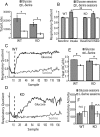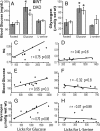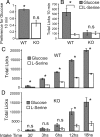Nutrient selection in the absence of taste receptor signaling
- PMID: 20534849
- PMCID: PMC6632684
- DOI: 10.1523/JNEUROSCI.5749-09.2010
Nutrient selection in the absence of taste receptor signaling
Abstract
When allowed to choose between different macronutrients, most animals display a strong attraction toward carbohydrates compared with proteins. It remains uncertain, however, whether this food selection pattern depends primarily on the sensory properties intrinsic to each nutrient or, alternatively, metabolic signals can act independently of the hedonic value of sweetness to stimulate elevated sugar intake. Here we show that Trpm5(-/-) mice, which lack the cellular mechanisms required for sweet and several forms of l-amino acid taste transduction, develop a robust preference for d-glucose compared with isocaloric l-serine independently of the perception of sweetness. Moreover, a close relationship was found between glucose oxidation and taste-independent nutrient intake levels, with animals increasing intake as a function of glucose oxidation rates. Furthermore, microdialysis measurements revealed nutrient-specific dopaminergic responses in accumbens and dorsal striatum during intragastric infusions of glucose or serine. Specifically, intragastric infusions of glucose induced significantly higher levels of dopamine release compared with isocaloric serine in both ventral and dorsal striatum. Intragastric stimulation of dopamine release seemed to depend on glucose utilization, because administration of an anti-metabolic glucose analog resulted in lower dopamine levels in striatum, an effect that was reversed by intravenous glucose infusions. Together, our findings suggest that carbohydrate-specific preferences can develop independently of taste quality or caloric load, an effect associated with the ability of a given nutrient to regulate glucose metabolism and stimulate brain dopamine centers.
Figures






Comment in
-
Chemosensation: Tasteless mice prefer sugar.Nat Rev Neurosci. 2010 Aug;11(8):538. doi: 10.1038/nrn2890. Nat Rev Neurosci. 2010. PMID: 20672430 No abstract available.
References
-
- Atwater WO. U.S. Farmer's Bulletin. Washington, DC: United States Department of Agriculture; 1910. Principles of nutrition and nutritive values of food.
-
- Benoit SC, Davidson TL. Interoceptive sensory signals produced by 24-hr food deprivation, pharmacological glucoprivation, and lipoprivation. Behav Neurosci. 1996;110:168–180. - PubMed
Publication types
MeSH terms
Substances
LinkOut - more resources
Full Text Sources
Medical
Molecular Biology Databases
